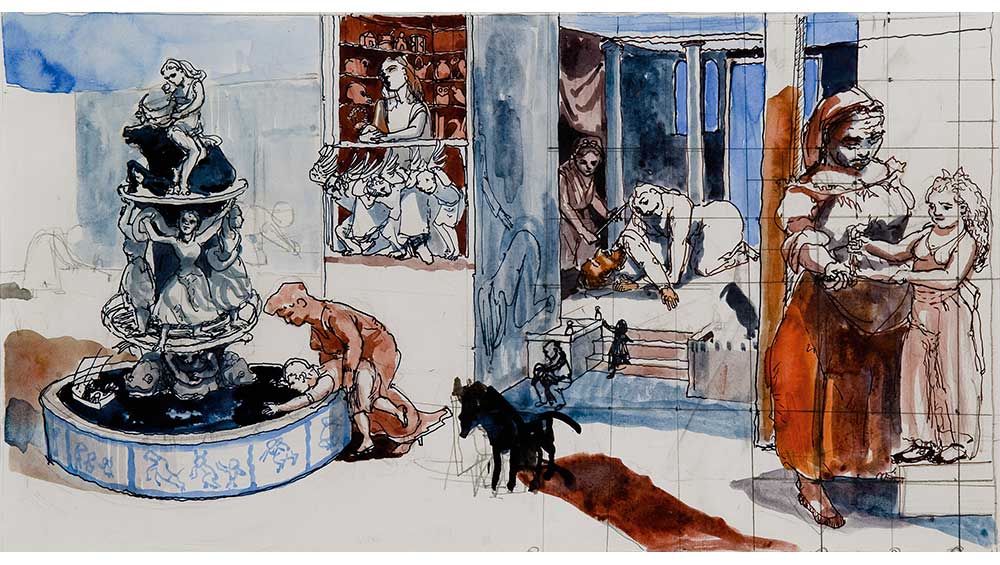
Paula Rego. Study for Crivelli’s Garden, 1990-91. Indian ink and wash on paper, 20.5 × 38 cm. Courtesy Ostrich Arts Ltd and Victoria Miro. © Ostrich Arts Ltd.
National Gallery, London
20 July – 29 October 2023
by BETH WILLIAMSON
It is more than 30 years since Paula Rego (1935-2022) was invited to become the National Gallery’s first Associate Artist (from 1990-91), creating a body of work inspired by the collection – Tales from the National Gallery – and presented to the public for just a few months, from 13 December 1991 until 1 March 1992. During her residency, Rego was also asked to create a mural for the gallery’s Sainsbury Wing dining room. This time, she took her inspiration from works by Carlo Crivelli (c1430/5-c1494) and, in particular, a 15th-century altarpiece, La Madonna della Rondine (The Madonna of the Swallow), painted after 1490 for the Franciscan church S Francesco dei Zoccolanti in the small Italian town of Matelica. She was also moved by her reading of stories of The Golden Legend, a 13th-century compilation of lives of the saints by Jacobus de Voragine. What Rego created in response was an enormously ambitious, almost 10-metre-long painting, Crivelli’s Garden, that puts strong women and storytelling at its centre.

Paula Rego. Crivelli’s Garden, 1990-91. Acrylic on canvas, 190 x 944.6 cm. The National Gallery, London. Presented by English Estates, 1991. © Ostrich Arts Ltd. Photo: The National Gallery, London.
Drawing on likenesses of family, friends and National Gallery staff, Rego filled her painting with courageous female saints and mythological women. As she said of her choices for this monumental work: “I prefer to paint women; and it was also a homage to them, their steadfastness and courage – the way they never gave up their faith.” In his preface to the exhibition catalogue, Rego’s son, Nick Willing, adds to this, describing it as “a celebration of female saints that sets aside the epic fanfare of Rubens or Uccello or countless other National Gallery painters to tell a different story of quiet assurance, defiance and survival”. Rego, then, created a bold riposte to patriarchy within the walls of London’s National Gallery – perhaps the last bastion of the patriarchal powers of western art history.
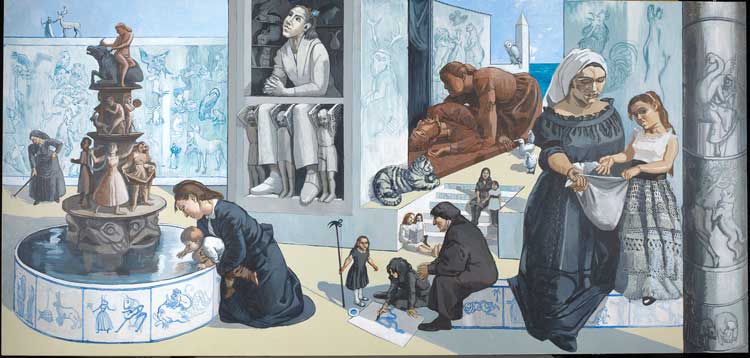
Paula Rego. Crivelli's Garden II, 1990-91. Acrylic on canvas, 189.9 × 401 cm. The National Gallery, London. Presented by English Estates, 1991. © Ostrich Arts Ltd. Photo: The National Gallery, London.
Thinking about how women and their experiences are represented in painting, and more broadly the role of women in society and religion, Rego painted strong female figures inspired by the Virgin Mary, Saint Catherine, Saint Margaret, Saint Cecelia, Mary Magdalene and Judith and Delilah. Other women from myths, fables and biblical stories joined Rego’s cast of figures. Some of the figures are modelled on members of staff at the National Gallery at the time – Erika Langmuir and Ailsa Bhattacharya among them. As Rego explained: “Casting [models] is quite important because it’s part of my stimulus as a painter.” Memory is an important factor here, too, as can be seen in the poignant black-and-white photograph of Rego reproduced on the gallery wall. She is just 17 years old, and poses audaciously (right hand on heart and a cane in her left) in front of a blue-and-white-tiled panel of St Gertrude on the wall of the family home in Ericeira, Portugal, in 1952, addressing both the legacies of Catholicism and patriarchy that controlled her childhood during the oppressive Salazar regime in Portugal (1933-68) as well as her young adult life while training and working as an artist in London. Such bold defiant stances are everywhere in Crivelli’s Garden.
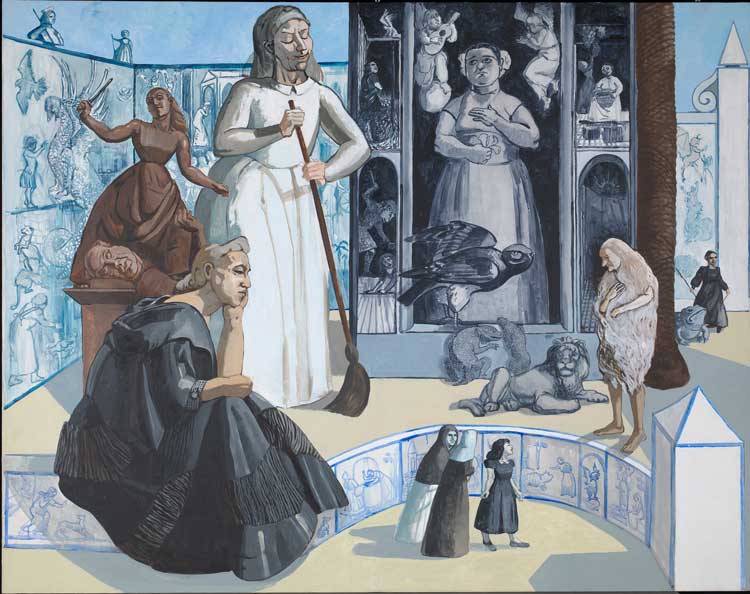
Paula Rego. Crivelli's Garden III, 1990-91. Acrylic on canvas, 189.9 × 240.9 cm. The National Gallery, London. Presented by English Estates, 1991. © Ostrich Arts Ltd. Photo: The National Gallery, London.
The environment that Rego creates in this painting, complete with pillars, fountain, balcony and secret spaces, shows us women in the midst of quotidian acts, such as sweeping the floor, sharing secrets or dancing, while also acting to enrich lives by supporting children in playing, drawing and reading. The small seated figure on the right of the picture holds an open book on her lap, pages devoid of words. The orientation of her upper body seems to gesture to the viewer to “read” the story in the painting while the blank pages invite an imaginative reading. The importance of story for Rego was recognised when, in 1976, she was awarded a grant from the Calouste Gulbenkian Foundation to research fairytales worldwide, resulting in a report that continued to inform her practice. She said of her work: “My paintings are stories, but they are not narratives in that they have no past or future. Everything happens in the present, incidents, daydreams, passions and consequences. They need characters and actions which evoke my feelings of fascination, fear and fun.”
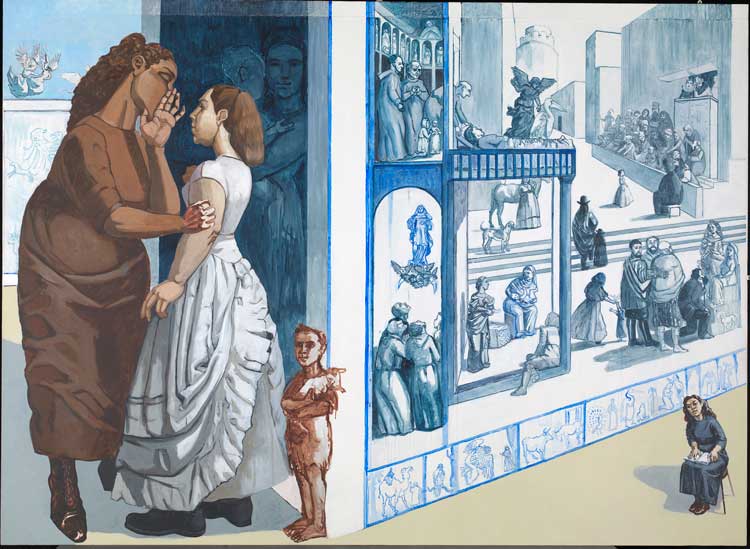
Paula Rego. Crivelli's Garden IV, 1990-91. Acrylic on canvas, 190 × 260.7 cm. The National Gallery, London. Presented by English Estates, 1991. © Ostrich Arts Ltd. Photo: The National Gallery, London.
That is precisely what Crivelli’s Garden does in its celebration of story, women and Portugal. The maze-like Portuguese garden with its signature blue-and-white tiles reimagines Crivelli’s La Madonna della Rondine and was sparked by his predella panel in particular. Crivelli’s depictions of saints are structured in five separate panels, each telling a different tale. In Rego’s presentation, the saints co-exist in the same space, architecturally structured, but in a manner that doesn’t quite make sense. It may be that she disregarded or subverted established norms of scale and perspective. Yet it also suggests a mischievousness on Rego’s part. Her account of time spent in the artist’s studio at the National Gallery (then in the basement) is full of fun: “I could creep upstairs and snatch at things, and bring them down with me to the basement, where I could munch away at them. And what I brought down here from upstairs varied a lot, but I always brought something into my den.”
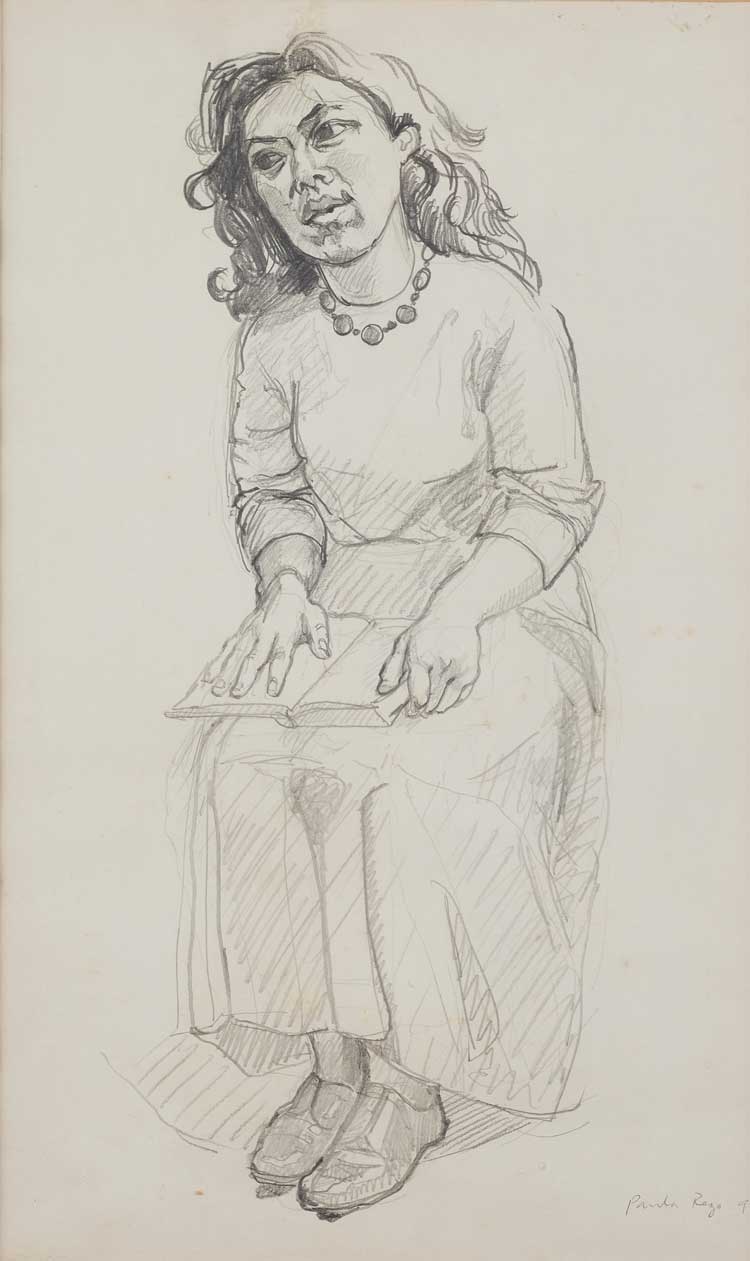
Paula Rego. Study for Crivelli’s Garden, 1990-91. Pencil on paper, 37 × 22.6 cm. Private Collection. © Ostrich Arts Ltd / photo: Alex Robson, Lyon & Turnbull.
Rego’s imaginary meanderings through the various panels of Crivelli’s painting are both joyous and sinister. Her powerful monumental figures, small tender figures, animals and insects, the playful disregard for scale, the melding of fables, biblical and mythological stories as well as her rich imagination, all come together to create this powerful riposte to the National Gallery’s male-dominated collection. It was, we are told, something of an amusement to her, at the time of its commissioning, that it was to be hung in the dining room, near the kitchen, an aside from the main collection. For the duration of this exhibition, the painting hangs in its own small gallery space, accompanied by Crivelli’s altarpiece and alongside a selection of preparatory drawings and studies. In this new context, the painting asserts is credentials, tells it stories and adds its voice to contemporary conversations about art, gender and religion. It has to be hoped that the National Gallery will put it on permanent display as a celebration of Rego’s remarkable achievements.